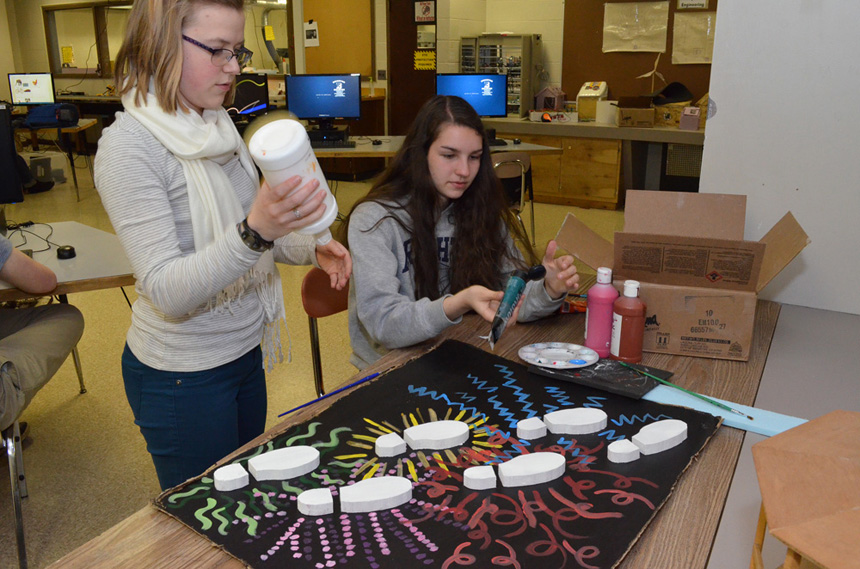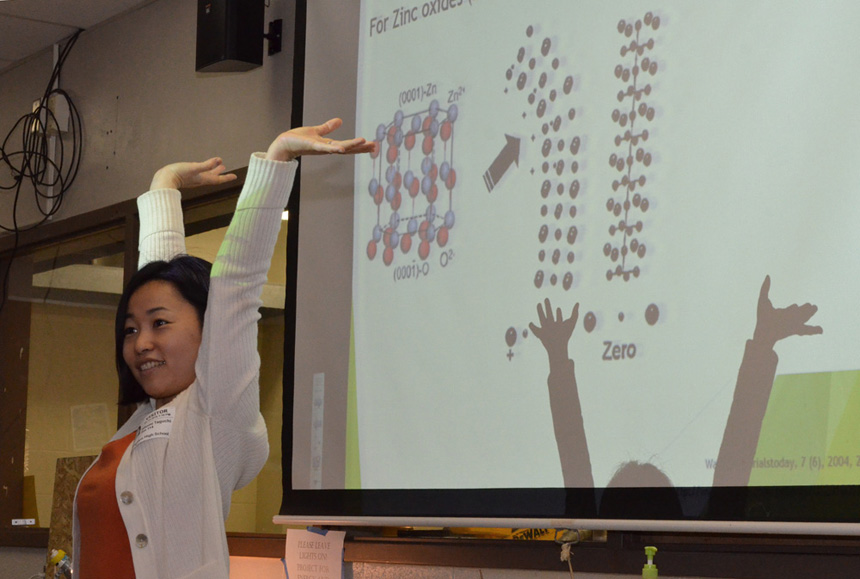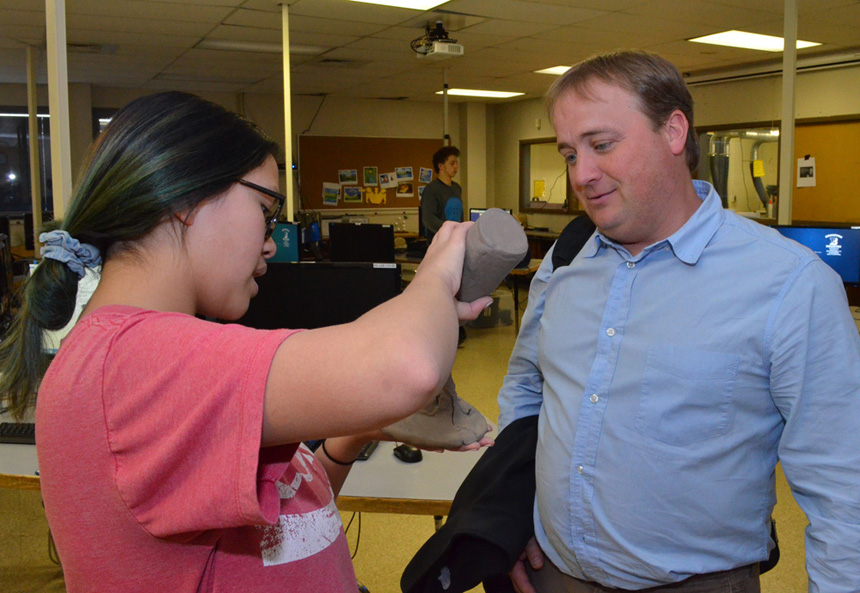Art helps students think creatively about science and technology
Brighton High School students Bethany Liano and Anna Shaughnessy work on their poster depicting how piezoelectricity can be generated from footsteps.
“Can everybody stretch?” Hitomi Mukaibo asked the 16 students in a Brighton High School class on sustainable energy.
As the students extended their arms upwards, Mukaibo, an assistant professor of chemical engineering at the University of Rochester, then asked them to bend first to one side, then the other.
It was a creative way to illustrate that pressuring on one side, and stretching on the other, causes zinc oxide to polarize - as part of Mukaibo’s lecture on how piezoelectricity offers an exciting approach to generating energy. As another example, she showed the students a brief video about an urban youth soccer field in Brazil that is now lighted at night by the pressure of the players’ feet on piezoelectric tiles placed underneath the surface.
Asst. Prof. Hitomi Mukaibo urges students to stretch to help illustrate the polarization of zinc oxide under pressure.
The stretching exercise also helped the Brighton students start thinking imaginatively about their assignment – creating art that illustrates how they feel about sustainable energy and its promise for the future.
The goal of Mukaibo’s collaboration with the Brighton High School, which began last summer, is to explore how STEAM – adding “art” to science, technology, engineering and math in classrooms – can stimulate students’ interest in STEM fields, encourage students to think creatively about how to apply technology to solve problems and help them communicate the importance of these solutions to others.
Championed by the Rhode Island School of Design, STEAM is based on the premise that true innovation comes from combining the mind of a scientist or technologist with that of an artist or designer – that art and design education teaches the flexible thinking, risk-taking and creative problem solving needed to address today’s most complex challenges, from healthcare to urban revitalization to global warming.
“I want the students to take away that science is not scary; it’s accessible and it’s exciting and it’s very creative,” Mukaibo said. “It’s not just math and it’s not just calculating how fast a ball can roll down a slope. It's something that can change the world.
“I want them to get connected with science and be excited about it. They don’t have to pursue it as their career, but I want them to be open and acceptable to the concept of science. I believe that STEAM is an excellent avenue to introduce the students to this discipline.”
Mukaibo’s talk followed presentations on prior days by Adam Eck, who teaches the sustainable energy course, and Katie Maley, a Brighton High School art teacher, who introduced Eck’s students to the various artistic tools and approaches for putting the STEAM project together.
After the presentations, the students split into teams to prepare their artwork, which took many forms.
Juniors Bethany Liano and Anna Shaughnessy created raised white outlines of shoes on a black poster, with bright colors representing the energy emanating from each footstep.
Students also had the option to illustrate other aspects of energy use. Junior Tasha Colton, for example, used clay to depict a can of oil leaking into the environment; she and her partner added illustrations to depict the impacts of pollution on people, wildlife and habitat.
“I don’t consider myself much of an artist,” said freshman Jack Kleinman, who took mandatory art classes in middle school, but hasn’t taken any since. His drawing depicts a molecular structure that could generate piezoelectricity, combined with a symbol of global sustainability. “It’s interesting,” he said of the STEAM approach, “a nice opportunity to be able to combine art with technology.”
Senior Julie Belanger, who does take art courses, concurred. “I like it when we get to build things instead of just listening to lectures,” she said. Her project also depicted piezoelectricity, a concept that “wouldn’t have made as much sense to me if I had to understand it just through words.”
Eck said the project was a valuable experience, especially for students who aren’t accustomed to expressing ideas through art and found themselves “outside their comfort zone.”
“It’s great to do different things,” Eck said. “If you only do what you’re comfortable with, you’re never going to make any progress.”
“l am sure they had no idea what piezoelectricity was before we started,” he added. “They definitely have a better understanding of what that is.”
Brighton High School student Tasha Colton shows the progress she’s made on her project to teacher Adam Eck.



